British Science Fiction writer, Allen Ashley loves “Greek In The Wind”
He sees it as a Slipstream/Magic Realist story.
“Greek in the Wind” (review)
Hi again Richard,
This is a top story. I love the idea of a key fob acting like a snow shaker and displaying the life and history of the narrator’s grandfather. And the way that history gradually takes a different turn in a sort of Slipstream / Magic Realist manner – great stuff. And the concept of “the agency of unknown relatives” is pretty creepy.
All the best,
Allen
Review of “Greek In The Wind”
It’s brilliant. One of your best. Historical prose and fantastical poetry combine to form an unflinchingly honest and profound psychological and moral exploration of the past and its present and perhaps future ramifications. Images of unique specificity open the door to a larger world, where concrete pillars turn to dust and are scattered to the shifting winds…or something like that. As you can tell I’m not a literary critic. Excellent Richard, really.
MD Lewis
What did I think of “The Hermit”?
That’s not an easy question to answer.
On one level it strikes me as the literary equivalent of a cave painting, something that was written 20,000 years ago and only discovered now, and which surprises in its technical eloquence, and baffles as to the meaning of its depictions. At the same time its infused with this Beat poetry sensibility, the way it rolls and rambles and revisits characters and themes in time, woven together in a complex web. It is however even more inscrutable perhaps in its psychedelic permutations and imagery than much of that stuff. Yet, despite its strikingly original flights of thought, and iconoclastic convention-shattering construction, it is nevertheless anchored by a certain Saturnine quality, an ancient austerity, an ancient pain, as I said before, as though it were the first recorded confession of the world’s first man. Or witness. On another level, to me anyway, it almost doesn’t matter what you’re talking about. nor the requisite nods to literary elements like conflict and resolution. It’s the syntax, the writing itself, the thoughts themselves and the manner in which they are expressed that makes it so compelling. I think a professor could have a field day with this thing, analyzing it, fielding interpretations. There are some inescapable tangential references to modern tragic history as well. What does it all mean? Gessner keeps you guessing! Very original piece. Demands several re-readings.
MD Lewis
Review of Richard Gessner’s newly published
book “The Conduit and Other Visionary Tales of Morphing Whimsy”
Rising Shadow – review written by Seregil of Rhiminee. Published: 04 November 2017
Richard Gessner’s The Conduit and Other Visionary Tales of Morphing Whimsy was published by Rain Mountain Press in September 2017.
Information about Richard Gessner:
Richard Gessner’s fiction has been published in Air Fish: an anthology of speculative work, Rampike, Ice River, Coe Review, Another Chicago Magazine, Happy, The Act, Sein und Werden, Skidrow Penthouse, The Pannus Index, Fiction International and many other magazines. A collection, Excerpts from the Diary of a Neanderthal Dilettante & The Man in the Couch was published by Bomb Shelter Props. Gessner’s drawings and paintings have appeared in Raw Vision, Courier News, Asbury Park Press, Rampike, Skidrow Penthouse, and exhibited at Pleiades Gallery, Hamilton Street Gallery, Cry Baby Gallery, The Court Gallery and the Donald B. Palmer Museum. He lives in Montclair, New Jersey.
Information about The Conduit and Other Visionary Tales of Morphing Whimsy:
“What Gessner does best, perhaps, is create microcosms – self-contained worlds in which he has made up the rules and established the action. I’m reminded of a drop of water, which, under van Leeuwenhoek’s microscope, turned out to be teeming with alien creatures possessed of varied modes of swimming. I am reminded of Blake: Gessner dramatizes the Romantic poet’s belief that there is a world in a grain of sand. The Conduit, one of the more visionary pieces, demonstrates Gessner’s ability to expand space and uncover its inhabitants in a seemingly infinite regression. It begins as the tale of a man who has been stabbed in the heart crawls into a sewer pipe to die, but the pipe is an existential anomaly – ‘Huge, wide, longer than all-seeing memory’ – and harbors not only the wounded man, but also a good chunk of the universe.
“The surreal aspects of Gessner’s stories recall the work of French author Raymond Roussel (1877-1933). In Roussel’s novel Locus Solus, for example, we encounter a scientist who has invented a balloon-powered, road- building machine, which, using human teeth of varying hues of brown, is assembling a mosaic of a Native American warrior. While this is the sort of oddity a reader shouldn’t be surprised to turn up in a Gessner fiction, the language Roussel uses is Victorian in its formality and almost scrupulously objective – at least in translation – as might befit a scientist. Roussel’s novel is carried not so much by his style as by an array of ingenious curiosities. Gessner strikes a more equal balance between the poetry of the prose and the parade of strangeness, between whimsical wordplay and the progression of the tale itself.
“He is also relentlessly funny. Virtually every paragraph in Excerpts from the Diary of a Neanderthal Dilettante – the title is self-explanatory – presents the reader with material worthy of a stand- up routine.” – Vincent Czyz
A REVIEW OF RICHARD GESSNER’S THE CONDUIT AND OTHER VISIONARY TALES OF MORPHING WHIMSY
Richard Gessner’s The Conduit and Other Visionary Tales of Morphing Whimsy is an enticing and impressive feast of literary surrealism and playful prose. It’s a no-holds-barred thrill-ride into the wondrous world of unexpected and whimsical happenings that are anything but ordinary.
The Conduit and Other Visionary Tales of Morphing Whimsy is one of the few collections which perfectly encapsulate what literary surrealism is all about, because it has unexpectedness, whimsiness and – above all else – beautiful and lyrical prose. The unexpected and whimsy elements are gorgeously displayed in the stories.
I love the author’s prose, because it has a lyrical feel to it. He effortlessly delivers delicious sights and wondrous vistas to his readers. His literary playfulness and his unique writing style is reminiscent of Brendan Connell. I was impressed by the prose, because I enjoy reading literary prose that is filled with details and evokes a sense of strangeness.
This collection may not be to everyone’s liking due to its strange and surreal contents, but that’s one of the most important reasons why it should be read. I strongly believe that we need more collections like this one, because they invigorate literary surrealism and bring freshness to it.
This collection contains the following stories:
The Zoo-brary
Excerpts from the Diary of a Neanderthal Dilettante
The Conduit
The Ball
The Unicyclist
The Embezzler
The Ink Device
Arbitration, At Goo…
The Unpatented Universe
The Hermit
Vanity
The Parallel Between the Cake and the Tail
The Olfactory Inversion
Status
The Fool
The Widow’s Peak Ghost
The Funeral Service
The Man in the Couch
Caviar
Lady in Transit
The Sleepwalker
The Battery Song
White Fuzz
What suprised me most about these stories is that they have plenty of depth and layers. Surreal fiction is seldom as multilayered as it is in this collection. I found myself being amazed by the subtle complexity of the stories, because they give quite a lot of food for thoughts.
One of the most intriguing things about this collection is that the author has created self-contained microcosms with rules of their own. These microcosms are filled with delicious and imaginative details that will astonish readers and they are distinctly different from what other authors have created.
“The Unicyclist” and “Arbitration, At Goo” offer readers surprisingly original and memorable visions of surreal strangeness. In “The Unicyclist”, clusters of duck-billed platypus eggs are multiplying in the scrotum of a unicycling nomad as he pedals onward and protects the precious bluish eggs. In “Arbitration, At Goo” two continents are linked by a pipeline through which babyfood flows and links the respecting populations by their diet, and the inhabitants of both continents have regressed to a permanent condition of teething.
Surreal strangeness does merely appear in the above mentioned stories, but can also be found in other stories. “The Conduit” tells of a man who has been stabbed in the heart at the edge of a pipe. The man crawls inside the pipe to live with the wound. What follows next is a veritable banquet of surreal imagery ranging from the ancestors of the victim and assailant to enemy remoras. “The Widow’s Peak Ghost” is an excellent piece of flash fiction, because it tells of a man who travels the route of his hairline and finds the ghost of his widow’s peak buried in a pore of scalp oil dust.
“The Funeral Service” offers readers a quirky vision of medical school where an anatomy teacher is half tiger and half rubber ostrich and lives inside a cadaver on a dissecting table. I like this story very much, because it is simultaneously amusing and macabre. What becomes of the medical student when he becomes a graveyard for the dead is simply amazing.
“Excerpts from the Diary of a Neanderthal Dilettante” is a brilliant story that consists of short diary entries. It’s a wholly original look at such things as art, literature, students and teachers, because the author approaches them from a new direction and examines everything in his own unique and amusing way. I have to mention that this story left me wanting more, because it is not often that readers are given an opportunity to read this kind of stories.
I enjoyed reading about the protagonist, his past and his condition in “The Hermit”, because the author writes intriguingly about him and created a multilayered vision of his life and deeds. The German sentences have stuck to my mind, because German is not often seen in literary speculative fiction (I studied German for a few years at school). It adds a level of fascination and excitement to this well-constructed story.
In my opinion, “The Parallel Between The Cake and The Tail” is a fascinatingly weird and thought-provoking tale about a groom and a surreal wedding feast. It was truly intriguing to read about how the groom felt about cutting the cake, because the story takes a leap into the fantastical realm of the surreal. This story is a perfect example of subtly complex literary fiction, because it has several elements that are playfully yet strangely logically bound together.
The tranformation described in “The Fool” intrigued me with its strangeness, because I have a soft spot for fiction in which characters experience transformations that defy the laws of nature. The way the author explores the fool’s fate and how his appearance changes has an uncanny feel of freshness to it.
The combination of surreal, thought-provoking, metaphysical and philosophical elements works perfectly in these stories, because they have several layers that are gradually revealed to the reader. The layered (and complex) structure makes them unique. The author fluently explores the human condition, self-awareness, metamorphoses and identity by means of literary surrealism.
The author’s way of writing about strange changes and metamorphoses feels vivid and has a strong sense of wonder and curiosity to it. He fluently describes what happens to his characters and how they envision their environments and situations. In some of the stories, his characters have springs stuck through their bodies, a dead man is worried that worms won’t like his enbalming fluid and a man uses albino mice to cure his baldness etc. It was enjoyable to read about each of the characters and their fates and predicaments, because their situations are mind-bogglingly peculiar and thought-provoking.
Richard Gessner’s quirky and twisted humour strongly appeals to me. I find his sense of humour highly enjoyable and wonderfully strange. It’s great that he has spiced up his stories with quirky humour and has dared to experiment with unconventional elements, because it marks him as a unique talent in the field of literary surrealism. In my opinion, Richard Gessner is an author to watch, because I have a feeling that this collection is merely a taste of what is to come.
The Conduit and Other Visionary Tales of Morphing Whimsy will please the appetites of those who are willing to read something different and allow themselves an opportunity to be seduced by beautiful prose and imaginative stories that push and stretch the boundaries of surrealism in a whimsical way. It’s one of the most original collections of the year and should not be missed by readers who love literary fiction and speculative ficton.
This collection has a few elements that strongly remind me of stories written by Brendan Connell and Rhys Hughes. It also contains elements that are reminiscent of Franz Kafka and Raymond Roussel (especially Roussel’s Locus Solus comes to mind when reading this collection).
Richard Gessner’s The Conduit and Other Visionary Tales of Morphing Whimsy is one of the most pleasant and most unique reading experiences of the year. I sincerely hope that the author will continue to write more stories, because he has his own voice and he dares to write his own kind of stories. I highly recommend this collection to everyone who loves surrealism and beautiful prose.
Highly recommended!
Download postcard – Richard_Gessner_Solo-Show_Library
Out of Oxford – review by g emil reutter
Welcome to the strange world of Richard Gessner where words and images matter. Gessner provides the reader with fresh images, use of words and stories that may or may not be about what they appear to be. Surreal? Maybe. Or they may just be reality in disguise.
The Zoo-Bray is located in the basement of a library. Those kept in the basement, (dark?), are writers of every kind. Parking-ticket scribblers face classical versifiers—Subpoena makers face street poets to produce spontaneous legal writs–… The forgotten face the immortal–. All of them are kept under the watchful eye of the zoo-breeder who wanders through the maze of hallways listening to the congress of burgeoning tete-a-tetes caught up in an infectious meld of snowballing ideas. He tells us at the center is an incubator where the pairs of the most promising writers chosen by the zoo-breeder are placed to mate and give birth. Gessner tells us the zoo-breeder decides what books make it to the upper shelves and what ones do not. Now the story could be viewed a surreal or a thinly masked critique of cookie cutter MFA programs.
Gessner gives us a wide ranging group of stories such as Excerpts From the Diary of a Neanderthal Dilettante. The Conduit a tale of a man stabbed in the heart seeking refuge in a pipe:Moving down the windy concrete tunnel, listening for his arteries drain, he leaves a red carpet for the assailant’s knife. Millennial scorpion stinging itself drowning in cesspools of regeneration. Hug, wide, longer than all seeing memory. The pipe sparkles with light, twinkling with blood hitting the cold air. The strangeness of the travel of the man in the pipe with dance callers, ancestors, wedding rings looping, ego dust and random chaos. Weird images carefully crafted by a writer who has earned his chops.
He gives us hermits, a unicyclist, arbitrators, a man in a couch and so much more wrapped in unnatural situations. Gessner looks at the world through distorted glasses and yet as the reader moves through this work all comes into view. Such as in this flash fiction piece, The Pelican’s Tonsils:
A psychiatrist stands in the ocean, wearing his patient’s galoshes, waiting for barnacles to adhere to them.
His framed doctor’s degree has escaped from his office wall and taken up residence inside the pouch of a pelican sitting on a far off rock jutting from the ocean.
In the stark wetness of the pouch, the lettering from the degree wears off getting stuck to the pelican’s tonsils. When the pelican dives for fish its tonsils wiggle, rearranging the lettering from the doctors degree.
In order to restore his official identity and career, the psychiatrist affects a man of action stance, preparing to swim out into the ocean and give the pelican a tonsillectomy—but the barnacles clustering on his patient’s galoshes keep him anchored to the shore as he attempts to swim—the crustaceous ball and chain keeping him forever split!
Gessner is a master of imagery, metaphor, of the unnatural setting and has produced a fantastic collection of bizarre stories that are equally disturbing and fantastic.
Richard Gessner – Left-Handed Author and Artist
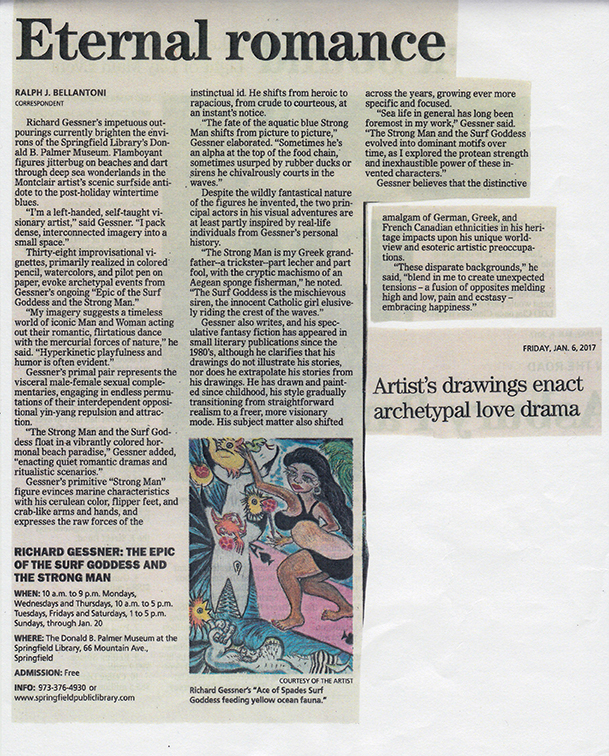
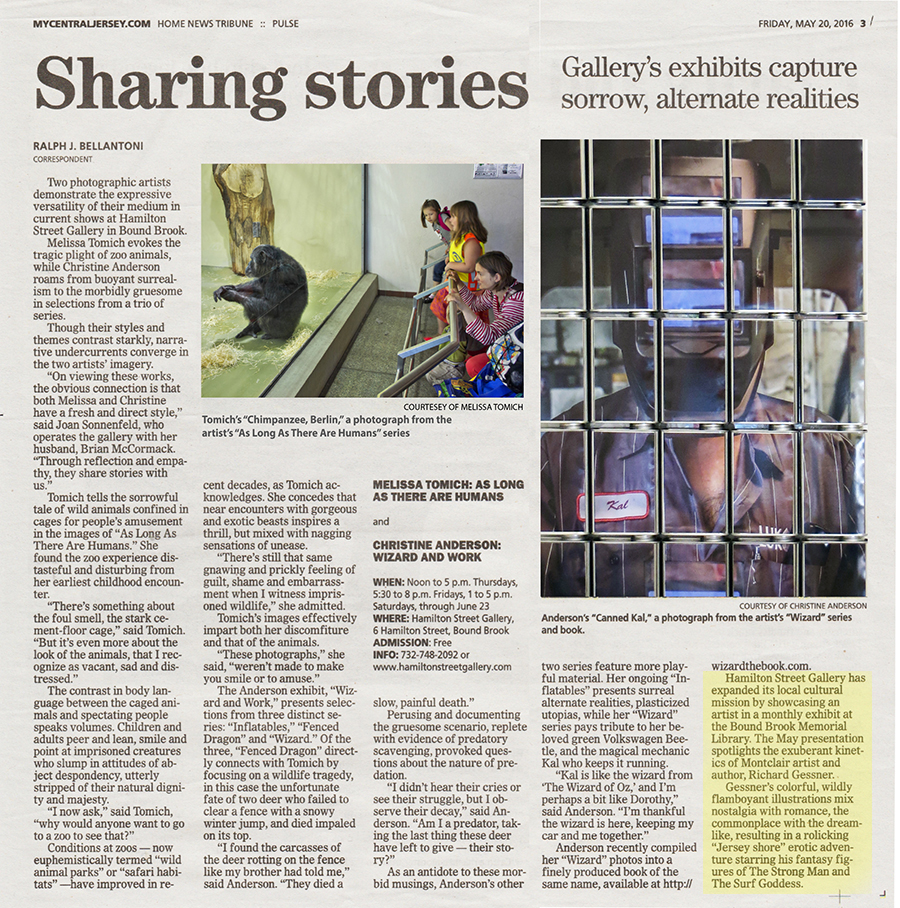
Mention in Hamilton Street Gallery Courier News article
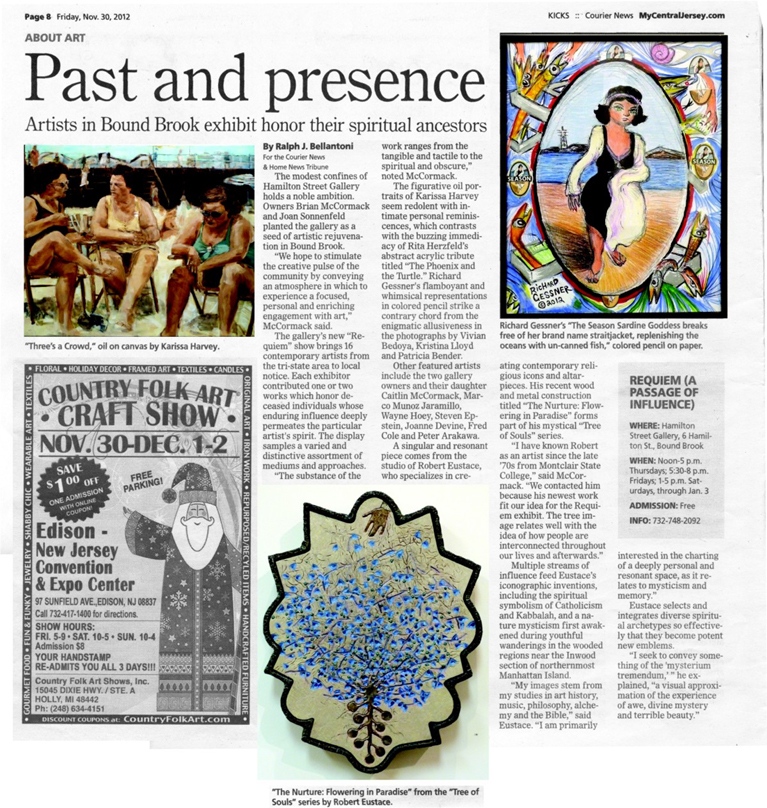
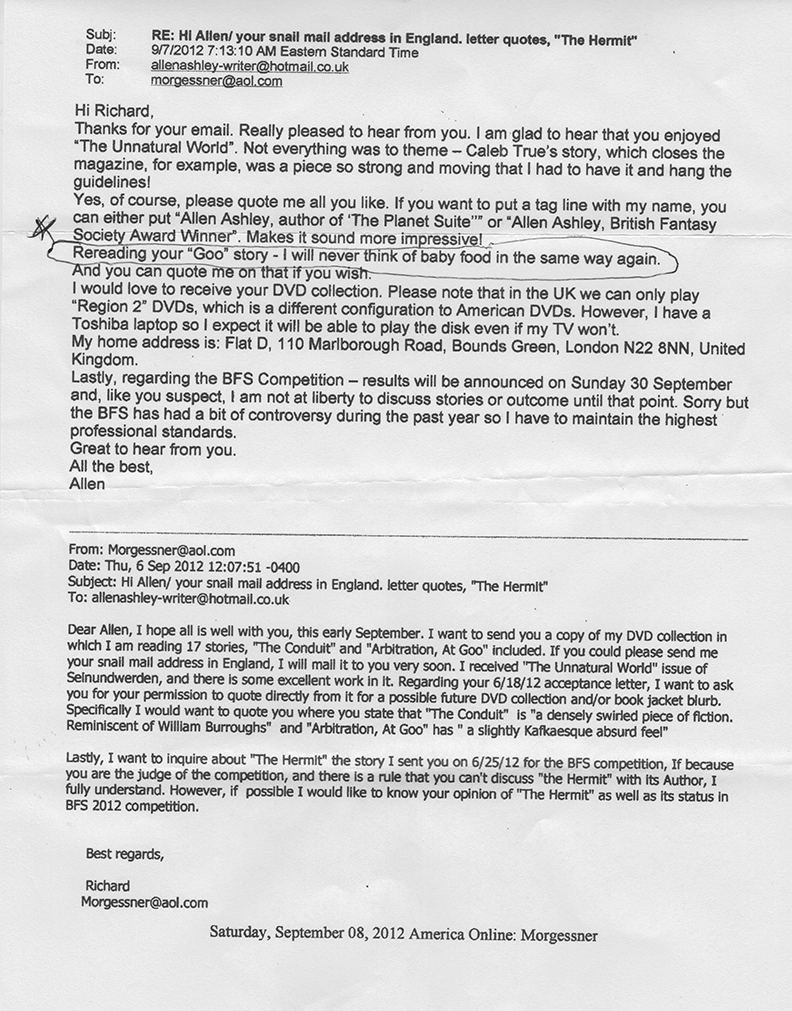
Letter fro Allen Ashly science fiction writer
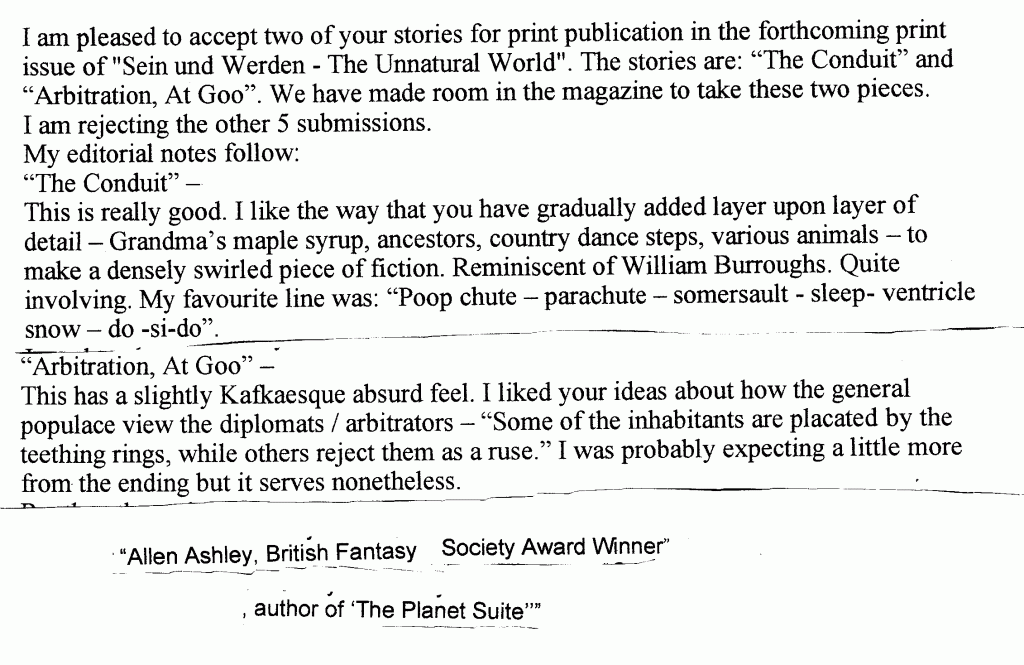

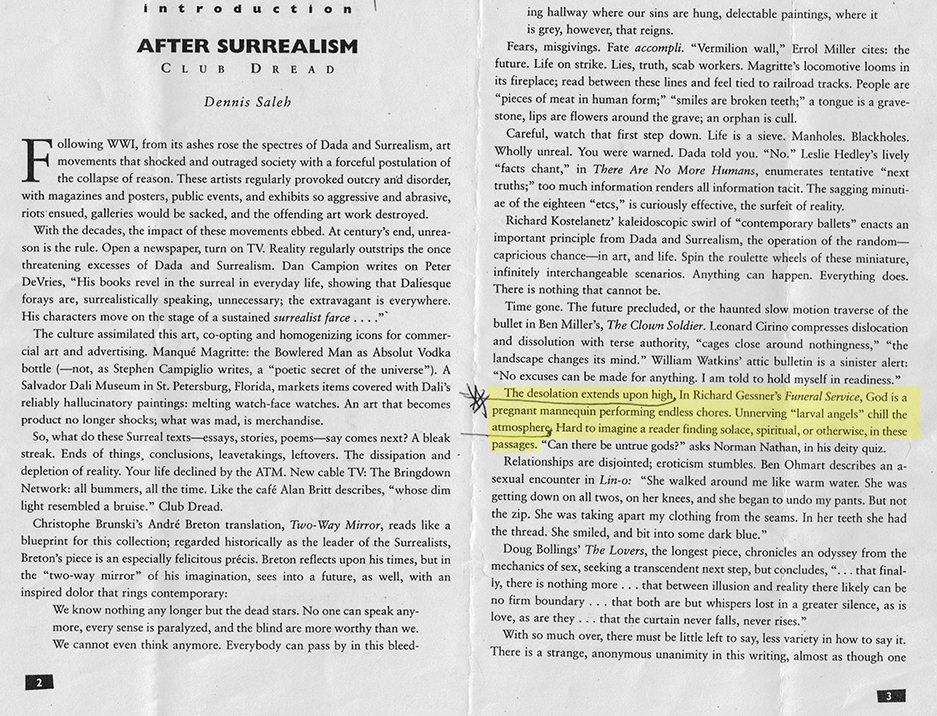
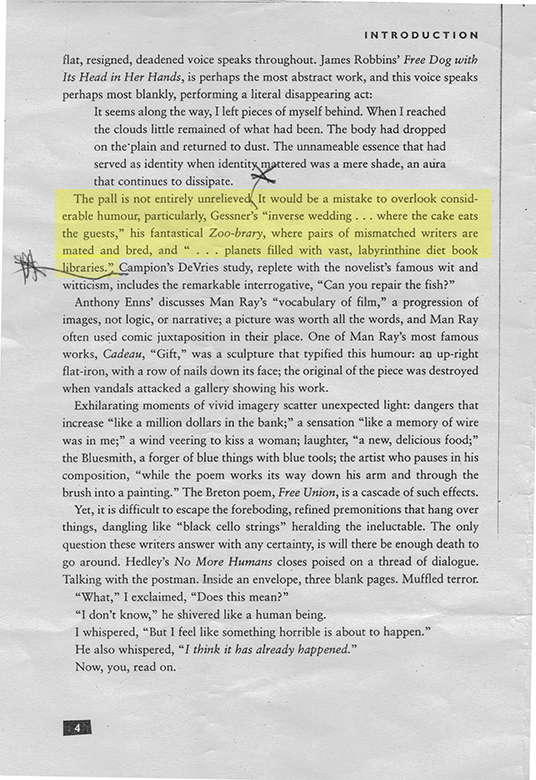
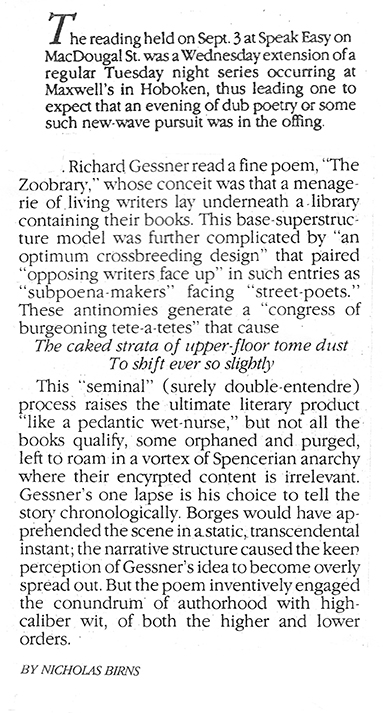

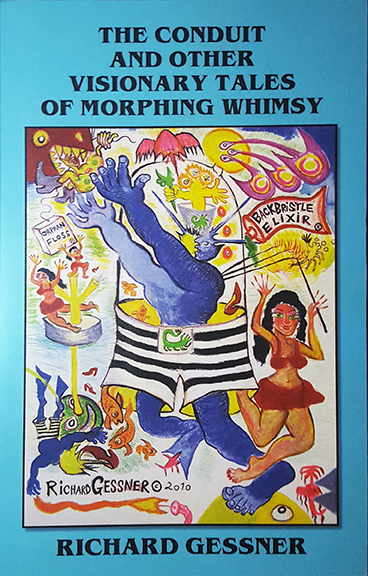
 We are always happy to feature left-handers with special talents which they attribute to being left-handed and Richard Gessner contacted us recently with some details of his books and artwork as well as his own personal history and how being left-handed has affected his work.
We are always happy to feature left-handers with special talents which they attribute to being left-handed and Richard Gessner contacted us recently with some details of his books and artwork as well as his own personal history and how being left-handed has affected his work.
 In fact, I can read and write backwards with ease, exploring the unknown, hidden aspects of consciousness, mining the psychic basement, the intuitive, irrational and absurd to reach a higher “Sense” beyond the logic of the pedestrian. To quote Novelist and Short story Writer Vincent Czyz “Gessner’s head is a sort of cavern piled high with such wonders – original images, fresh metaphors, mind-stretching scenarios and alternate world orders”
In fact, I can read and write backwards with ease, exploring the unknown, hidden aspects of consciousness, mining the psychic basement, the intuitive, irrational and absurd to reach a higher “Sense” beyond the logic of the pedestrian. To quote Novelist and Short story Writer Vincent Czyz “Gessner’s head is a sort of cavern piled high with such wonders – original images, fresh metaphors, mind-stretching scenarios and alternate world orders”
